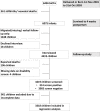Prenatal and perinatal risk factors for disability in a rural Nepali birth cohort
- PMID: 29082010
- PMCID: PMC5656139
- DOI: 10.1136/bmjgh-2017-000312
Prenatal and perinatal risk factors for disability in a rural Nepali birth cohort
Abstract
Background: Improving newborn health remains a global health priority. Little however is known about the neurodevelopmental consequences for survivors of complications in pregnancy, labour and the neonatal period in in low-income countries outside of small selective and typically urban facility studies. We ask which antenatal, birth and neonatal factors are associated with disability in childhood in a large community birth cohort from rural Nepal.
Methods: 6436 infants were recruited during a cluster randomised control trial (RCT) of participatory women's groups (ISRCTN31137309), of whom 6075 survived beyond 28 days. At mean age of 11∙5 years (range 9.5-13.1), 4219 children (27% lost to follow-up) were available for disability screening which was conducted by face-to-face interview using the Module on Child Functioning and Disability produced by the Washington Group/UNICEF. Hypothesised risk factors for disability underwent multivariable regression modelling.
Findings: Overall prevalence of disability was 7.4%. Maternal underweight (OR 1.44 (95% CI 1.01-2.08)), maternal cohabitation under 16 years of age (OR 1.50 (1.13-2.00)), standardised infant weight at 1 month (OR 0.82 (0.71-0.95)) and reported infant diarrhoea and vomiting in the first month (OR 2.48 (1.58-3.89)) were significantly associated with disability adjusted for trial allocation. The majority of hypothesised risk factors, including prematurity, were not significant.
Interpretation: Proxies for early marriage and low birth weight and a measure of maternal undernutrition were associated with increased odds of disability. The lack of association of most other recognised risk factors for adverse outcome and disability may be due to survival bias.
Keywords: Paediatrics; child health; cohort study; epidemiology; health policy.
Conflict of interest statement
Competing interests: None declared.
Figures
Similar articles
-
Long-term impact of community-based participatory women's groups on child and maternal mortality and child disability: follow-up of a cluster randomised trial in rural Nepal.BMJ Glob Health. 2018 Dec 1;3(6):e001024. doi: 10.1136/bmjgh-2018-001024. eCollection 2018. BMJ Glob Health. 2018. PMID: 30588343 Free PMC article.
-
Effect of a participatory intervention with women's groups on birth outcomes in Nepal: cluster-randomised controlled trial.Lancet. 2004 Sep 11-17;364(9438):970-9. doi: 10.1016/S0140-6736(04)17021-9. Lancet. 2004. PMID: 15364188 Clinical Trial.
-
Protocol of the Low Birth Weight South Asia Trial (LBWSAT), a cluster-randomised controlled trial testing impact on birth weight and infant nutrition of Participatory Learning and Action through women's groups, with and without unconditional transfers of fortified food or cash during pregnancy in Nepal.BMC Pregnancy Childbirth. 2016 Oct 21;16(1):320. doi: 10.1186/s12884-016-1102-x. BMC Pregnancy Childbirth. 2016. PMID: 27769191 Free PMC article. Clinical Trial.
-
Strategies for optimising antenatal corticosteroid administration for women with anticipated preterm birth.Cochrane Database Syst Rev. 2020 May 26;5(5):CD013633. doi: 10.1002/14651858.CD013633. Cochrane Database Syst Rev. 2020. PMID: 32452555 Free PMC article.
-
Induction of labour at or beyond 37 weeks' gestation.Cochrane Database Syst Rev. 2020 Jul 15;7(7):CD004945. doi: 10.1002/14651858.CD004945.pub5. Cochrane Database Syst Rev. 2020. PMID: 32666584 Free PMC article.
Cited by
-
Long-term impact of community-based participatory women's groups on child and maternal mortality and child disability: follow-up of a cluster randomised trial in rural Nepal.BMJ Glob Health. 2018 Dec 1;3(6):e001024. doi: 10.1136/bmjgh-2018-001024. eCollection 2018. BMJ Glob Health. 2018. PMID: 30588343 Free PMC article.
-
The Estimated Prevalence of Autism in School-Aged Children Living in Rural Nepal Using a Population-Based Screening Tool.J Autism Dev Disord. 2018 Oct;48(10):3483-3498. doi: 10.1007/s10803-018-3610-1. J Autism Dev Disord. 2018. PMID: 29855757 Free PMC article.
-
Correlates of child functional difficulties status in Ghana: A further analysis of the 2017/18 multiple indicator cluster survey.Heliyon. 2020 Dec 15;6(12):e05727. doi: 10.1016/j.heliyon.2020.e05727. eCollection 2020 Dec. Heliyon. 2020. PMID: 33364496 Free PMC article.
-
Prevalence and associated factors of neurodevelopmental disability among infants in eastern Uganda: a population based study.BMC Pediatr. 2019 Oct 24;19(1):379. doi: 10.1186/s12887-019-1769-z. BMC Pediatr. 2019. PMID: 31651279 Free PMC article.
References
-
- United Nations Division for Social Policy and Development. Disability Inclusive Sustainable Development Goals. 2015. http://www.un.org/disabilities/documents/sdgs/disability_inclusive_sdgs.pdf (accessed 01/08/2016).
Grants and funding
LinkOut - more resources
Full Text Sources
Other Literature Sources


